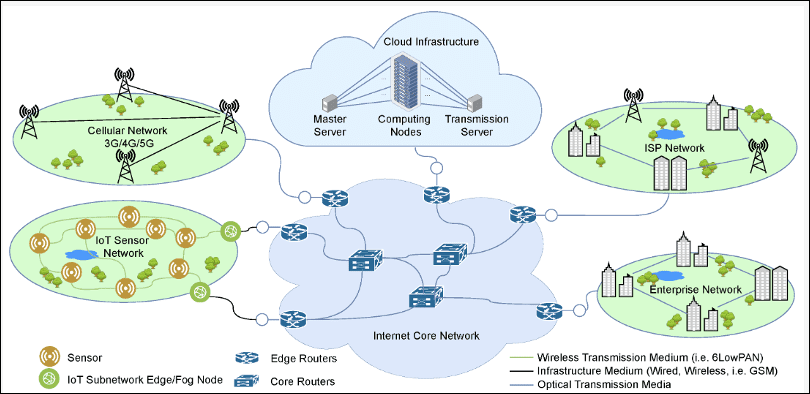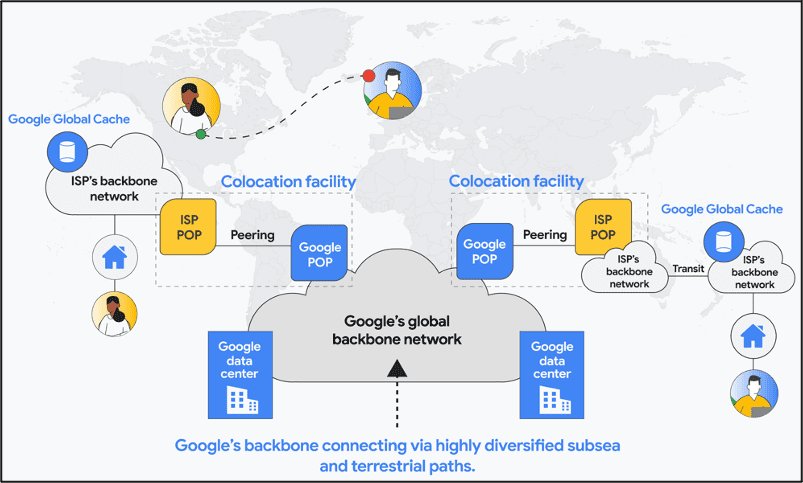Part1: Unleashing Network Potentials: Current State and Future Possibilities with AI/ML
By Vinay Tripathi with Ajay Lotan Thakur
Introduction
We live in an era of rapid digitization and ubiquitous connectivity where networks touch every aspect of our lives. From the global telecommunication infrastructure enabling seamless voice and data communication to the diverse social media platforms facilitating instant global interactions, the way we collaborate, communicate, and access information is heavily dependent on the seamless operation of networks. However, as networks continue to evolve, expanding in size and complexity, managing, provisioning, and optimizing them efficiently poses significant challenges.
Introducing Artificial Intelligence (AI) and Machine Learning (ML), offering a transformative solution to simplify network provisioning, streamline operations, enhance network performance, and unlock valuable insights from the vast amounts of network data. AI and ML empower network administrators, architects, planners, engineers, and managers with a range of capabilities that significantly improve network efficiency and effectiveness.
Type of Networks
Networks can be classified into various types based on their purpose, size, and geographical coverage. Some common types of networks include:
1. Core Networks:
- Form the backbone of the internet, connecting large geographical regions and major network providers.
- Characterized by high-speed data transmission, typically fiber optic cables, and redundant paths for reliability.
- Responsible for routing traffic between different parts of the internet and carrying large amounts of data.
2. Data Center Networks:
- Designed to support the infrastructure of data centers, where large amounts of data are processed and stored.
- Highly interconnected and optimized for low latency and high bandwidth to facilitate efficient communication between servers and storage systems.
- Often utilize specialized networking technologies such as Ethernet and InfiniBand.
3. Enterprise Networks:
- Connect devices and resources within an organization or company.
- Include local area networks (LANs) for devices within a building or campus and wide area networks (WANs) for connecting geographically dispersed sites.
- Provide secure and reliable connectivity for employees, customers, and partners.
4. Cellular Networks:
- Provide wireless connectivity for mobile devices such as smartphones, tablets, and IoT devices.
- Consists of cellular towers or base stations that communicate with mobile devices using radio waves.
- Offer various cellular technologies such as 2G, 3G, 4G, and 5G, each providing different levels of speed and capacity.
Here’s an example that demonstrates various types of networks:
Figure-1: Various types of Networks
Figure-2: Google Network Infrastructure
Network Functions
Networks are designed to achieve specific goals, for example, edge networks can have very different routing and switching requirements when compared to core networks. However, there are some functions which are common to all networks.
- Engineering:Deals with design, optimization, provision and development of the network infrastructure and services. Engineering teams ensure the network operates efficiently, reliability and meets all the performance and scale requirements.
- Capacity Planning & Forecasting:Estimates future demand of network resources such as routers, switches, servers, storage and bandwidth. It helps in network planning and scaling by analyzing history consumptions and future demand.
- Implementation:Physically deploys the network components like routers, switches, servers, etc. It integrates the systems to the rest of the network and services based on the designs and plans developed by the engineering team.
- Monitoring:Another critical function of network infrastructure which provides vital insights to the current state of network infrastructure. Data collected from the systems can be used by other network functions to improve network performance, reliability, and security.
- Operation:A crucial function of the network which focuses on day-to-day management, maintenance and support of network infrastructure and services. It ensures the network operates smoothly, efficiently and with least disruptions.
- Security:Maintains confidentiality and integrity of information and systems. It uses firewall, intrusion detection systems and access control lists to keep the network secure.
Network Without AI/ML
Many large-scale network outages result from human manual errors or automated system malfunctions. Avoiding such issues is difficult when humans are involved in daily operational decision-making. Many network functions have been automated in recent years, but they still rely on predefined values or actions that require continuous system or service updates. Additionally, there are still many networks or functions that are not automated due to a lack of expertise, resources, or willingness. Even in automated networks, operators must perform manual operations in certain situations, such as tooling infrastructure failures or recoveries. Some scenarios where automated and/or manual operations are performed in a network include:
- Manual/automated security provisions:
- Manual security provisions involve tasks such as manually configuring firewalls, intrusion detection systems, and other security devices.
- Automated security provisions involve using software tools to automate security tasks, such as vulnerability scanning, patch management, and threat detection.
- Manual/automated configuration of network devices (switches, routers, etc.):
- Manual configuration involves manually configuring network devices, such as switches and routers, using command-line interfaces or web-based interfaces.
- Automated configuration involves using software tools to automate the configuration of network devices, which can save time and reduce errors.
- Manual/automated monitoring dashboard with predefined values:
- Manual monitoring involves manually monitoring network performance and security metrics using technologies such as Telemetry, SNMP, and syslog.
- Automated monitoring involves using software tools to automate the monitoring of network metrics and generate alerts when predefined thresholds are exceeded.
- Manual/automated troubleshooting of network issues:
- Manual troubleshooting involves manually diagnosing and resolving network issues, such as connectivity problems, performance issues, and security breaches.
- Automated troubleshooting involves using software tools to automate the diagnosis and resolution of network issues, which can reduce the time it takes to resolve problems.
- Manual/automated mitigation of network events:
- Manual mitigation involves manually responding to network events, such as security breaches, denial-of-service attacks, and natural disasters.
- Automated mitigation involves using software tools to automate the response to network events, which can help to minimize the impact of these events.
- Manual/automated capacity planning process:
- Manual capacity planning involves manually forecasting network traffic demand and planning for future capacity needs.
- Automated capacity planning involves using software tools to automate the forecasting of network traffic demand and the planning of future capacity needs, which can help to ensure that the network has sufficient capacity to meet future demand. Automated solutions can save time, reduce errors, and improve efficiency.
NextGen Network Requirements
Next-generation networks must meet diverse use cases and deliver exceptional customer experiences. Network applications and use cases constantly evolve, necessitating adjustments in network design, technologies, and operations. Continuous optimization is needed to unleash the network’s full potential. For example, existing data center networks require redesign and optimization to meet the demands of AI/ML applications. Critical requirements that must be fulfilled by next-generation networks are as follows:
- Increased performance, reliability, and security: Networks must handle massive data volumes and complex workloads with high performance and low latency. Reliability and security are paramount, ensuring uninterrupted operations and safeguarding sensitive information.
- Customer-centric focus: Delivering a seamless and delightful customer experience is crucial. Networks must facilitate seamless coordination across business functions, enabling personalized services and addressing customer needs effectively.
- Managing massive complexity: The convergence of 5G, Internet of Things (IoT), AI/ML loads and edge computing introduces unprecedented complexity. Networks need to be equipped with advanced orchestration and management capabilities to handle this complexity efficiently.
- Value beyond connectivity: Networks should not be limited to providing mere connectivity. They must deliver value-added services and capabilities such as real-time analytics, edge computing, and network slicing to meet diverse customer requirements.
- Improved service assurance and issue prediction: Networks must proactively monitor and analyze network performance to predict potential issues before they impact customers. Fault detection and self-healing mechanisms are essential to ensure uninterrupted service availability.
- Measuring and optimizing customer experience: Networks should have built-in capabilities to measure and analyze customer experience metrics such as latency, packet loss, and jitter. This data can be leveraged to optimize network performance and rectify areas of improvement.
- Understanding customer expectations: Networks must provide insights into customer expectations and evolving needs. This can be achieved through surveys, feedback mechanisms, and real-time monitoring of customer interactions.
- Increased efficiency and intelligence: Networks should incorporate AI and ML technologies to automate tasks, optimize resource allocation, and enhance overall network efficiency and intelligence.
Conclusions
Future networks need AI/ML integration to fulfill the next generation of requirements. AI/ML can make networks more efficient, secure, reliable, and scalable. AI/ML can effectively monitor and alert operators, utilizes resources efficiently, make network customer centric and faster delivery of services. In the next blog, we will discuss AI/ML use cases, benefits, limitations, and projections.
References
- https://www.mdpi.com/1424-8220/21/11/3898
- https://cloud.google.com/blog/products/infrastructure/google-network-infrastructure-investments
**** This blog post was written with the assistance of Google’s Gemini. The AI was used to generate initial draft, rephrasing, and brainstorming, which I then refined, edited, and expanded upon.
2 thoughts on “Part1: Unleashing Network Potentials: Current State and Future Possibilities with AI/ML”
Comments are closed.





From Google’s Gemini:
A recent industry summit highlighted how AI can be used to:
-Predict and prevent problems: Imagine a network that can anticipate outages before they happen! AI can analyze data to identify patterns and potential trouble spots.
-Optimize resources: AI can help carriers distribute resources more efficiently, like automatically adjusting power usage based on network traffic.
-Personalize services: Carriers could use AI to offer custom plans and features to each customer, based on their usage patterns.
However, there are still hurdles to overcome. These include:
-Early stages of development: AI technology is still evolving, and it takes time to implement it effectively across complex networks.
-Data privacy concerns: Training AI models requires a lot of data, and carriers need to ensure they’re handling customer data responsibly.
Overall, the future looks bright for AI in the carrier industry. It has the potential to make networks more efficient, reliable, and personalized for customers, but there’s still work to be done before we see the full benefits.
Dec 3, 2024 remarks by Nvidia’s Colette Kress – Executive Vice President and Chief Financial Officer:
Our Networking business is one of the most important additions that we added when we went to a datacenter scale. The ability to think through, not just the time where the data, the work is being done at a data processing or the use of the compute and/or the GPU is essential to think through the Networking’s position inside of that datacenter.
So we have two different offerings. We have InfiniBand and InfiniBand had tremendous success with many of the largest supercomputers in the world for decades. And that has been very important in terms of the size of data, the size of speed of data going through. It had different views in terms of how to deal with the traffic that will be there.
Ethernet, a great configuration that is the standard for many of the enterprises. But Ethernet was not built for AI. Ethernet was just built for the networking inside of datacenters. So we are taking some of the best of the breeds of what you see in terms of inter InfiniBand and creating Ethernet for AI. That allows customers now, both the choice between those. We can be full end-to-end systems with InfiniBand and now you have your choice in terms of what we do with Ethernet.
Both of these things are a growth option for us. In terms of this last quarter, we had some timing issues. But now, what you will see in terms of the continuation of our Networking will definitely grow. With our designs in terms of Networking with our compute, we have some of the strongest clusters that are being built and also using our Networking. That connection that we have done has been a very important part of the work that we’ve done since the acquisition of Mellanox. Folks do represent and understand our use of networking and how that can help their overall system as a whole.
https://seekingalpha.com/article/4741811-nvidia-corporation-nvda-ubs-global-technology-conference-transcript